Dyson V15 Detect
Two-minute review
When Dyson first unveiled the V15 Detect in the US in March 2021, we were excited by the new concept of the laser built into a cleaning head. We couldn’t wait for it to arrive in Australia and try it for ourselves. Now that it has and we have used it, we think it's superfluous.
We loved the laser the first few times we used the newly designed Fluffy tool. After that, though, we found ourselves just leaving it switched off for the most part, only turning it on when we needed to get into nooks and crannies that usually get missed during general cleaning.
And that’s our only complaint – if you want to even call it a complaint – when it comes to the Dyson V15 Detect. As a vacuum cleaner, it’s a powerful beast, able to suck up practically anything it finds in its path (even cereal).
What we really like about the V15 Detect is its ability to identify particle size, classify them and then graphically display how much of each category you’ve cleaned up. It’s part of Dyson’s campaign to “scientifically prove” that you’ve given your home the best clean possible, especially given the current pandemic.
Then there’s the new Hair Screw Tool – it’s been designed to suck up hair without any tangles on the brush, making it easy to maintain in the long run. This attachment is available to buy separately and can be used with the older Dyson models, but comes as a standard attachment in the box with the V15 models.
Most other features of the V15 have been inherited from the Dyson V11 models, the ones with the standard 0.76L bins. There’s the same max 60-minute fade-free runtime, the dynamic suction – albeit more powerful with the V15 – and the digital display. This screen now even shows you the graphical representation of what you’ve vacuumed up, in addition to the returning battery life indication and power level.
Despite the extra tech that the V15 packs – namely the laser and a piezo sensor that detects the sound vibrations of dust particles – the V15 Detect weighs only a teensy bit more than the V11. In use, the difference is so marginal that you won’t even know it (if you’ve used the V11 that is).
As with all things new at Dyson, the V15 Detect comes with a very premium price tag. We thought the V11 was expensive when it first launched, but now the V15 Detect takes the title of the most expensive Dyson yet, with the V15 Detect Total Clean costing more than the Dyson Outsize.
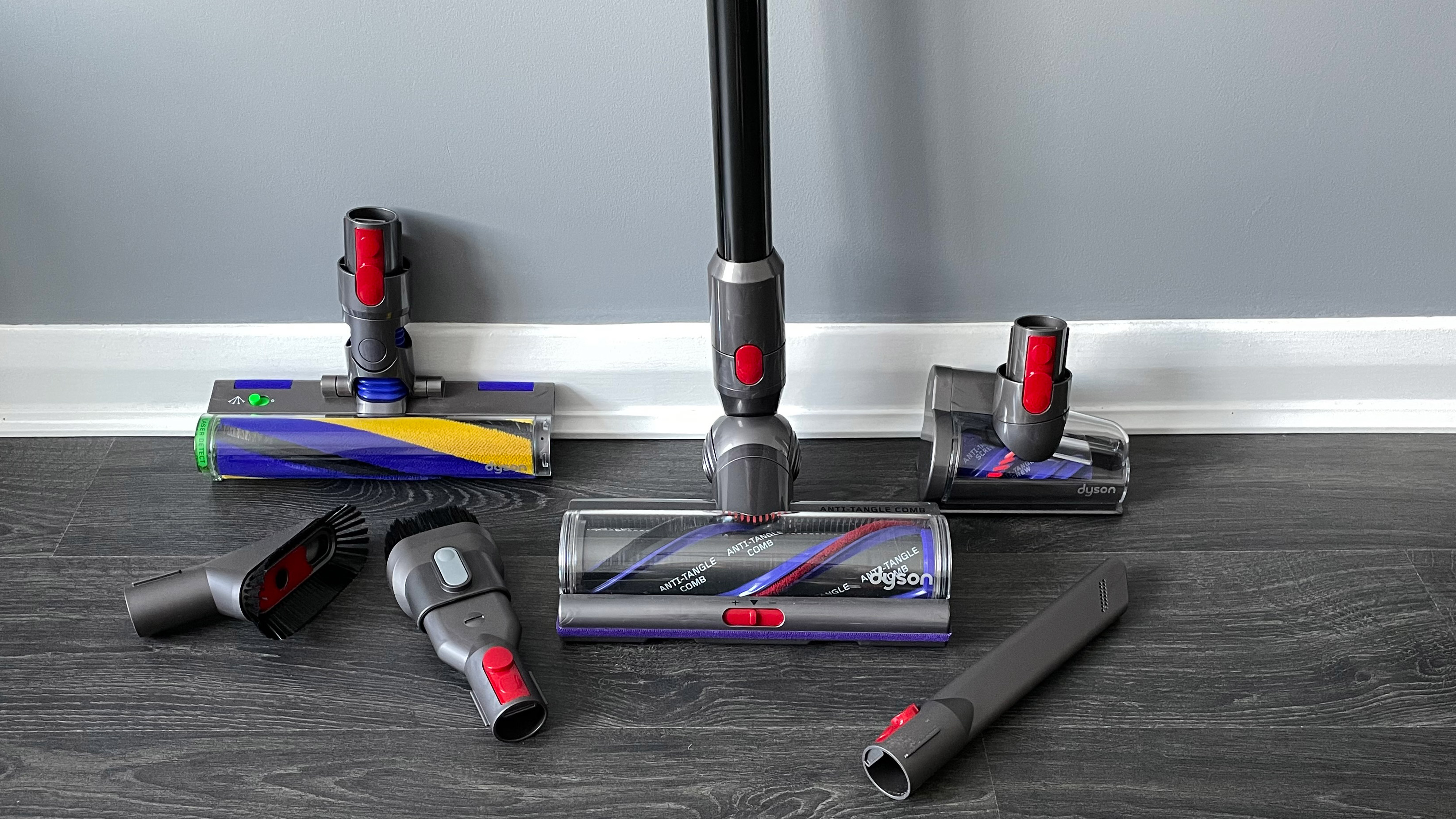
Dyson V15 Detect price and availability
- Launched in Australia and New Zealand in May 2021
- Starting price of AU$1,399 / NZ$1,499
- Two models of the V15 Detect available
Although the Dyson V15 Detect was announced in the US in March 2021, it took a couple of months to arrive south of the equator. Since May 2021, two models of the V15 Detect have been available in Australia and New Zealand – the base model, called the V15 Detect Total Clean costs AU$1,399 / NZ$1,499, while the V15 Detect Absolute Extra (which comes with a redesigned filter and a free-standing dock) costs an eye-watering AU$1,449 / NZ$1,549. There’s no difference between the two V15 Detect models except for the aforementioned extra filter and free-standing dock in the expensive option.
It must be noted that the Absolute Extra is currently only available in Australia and New Zealand. The V15 Detect Total Clean, however, is the exact same thing as the ‘V15 Detect’ in the US and the ‘V15 Detect Absolute’ in the UK.
Either way, the V15 Detect models are the most expensive Dysons yet, with the Total Clean outdoing the RRP of the Dyson Outsize by a small margin.
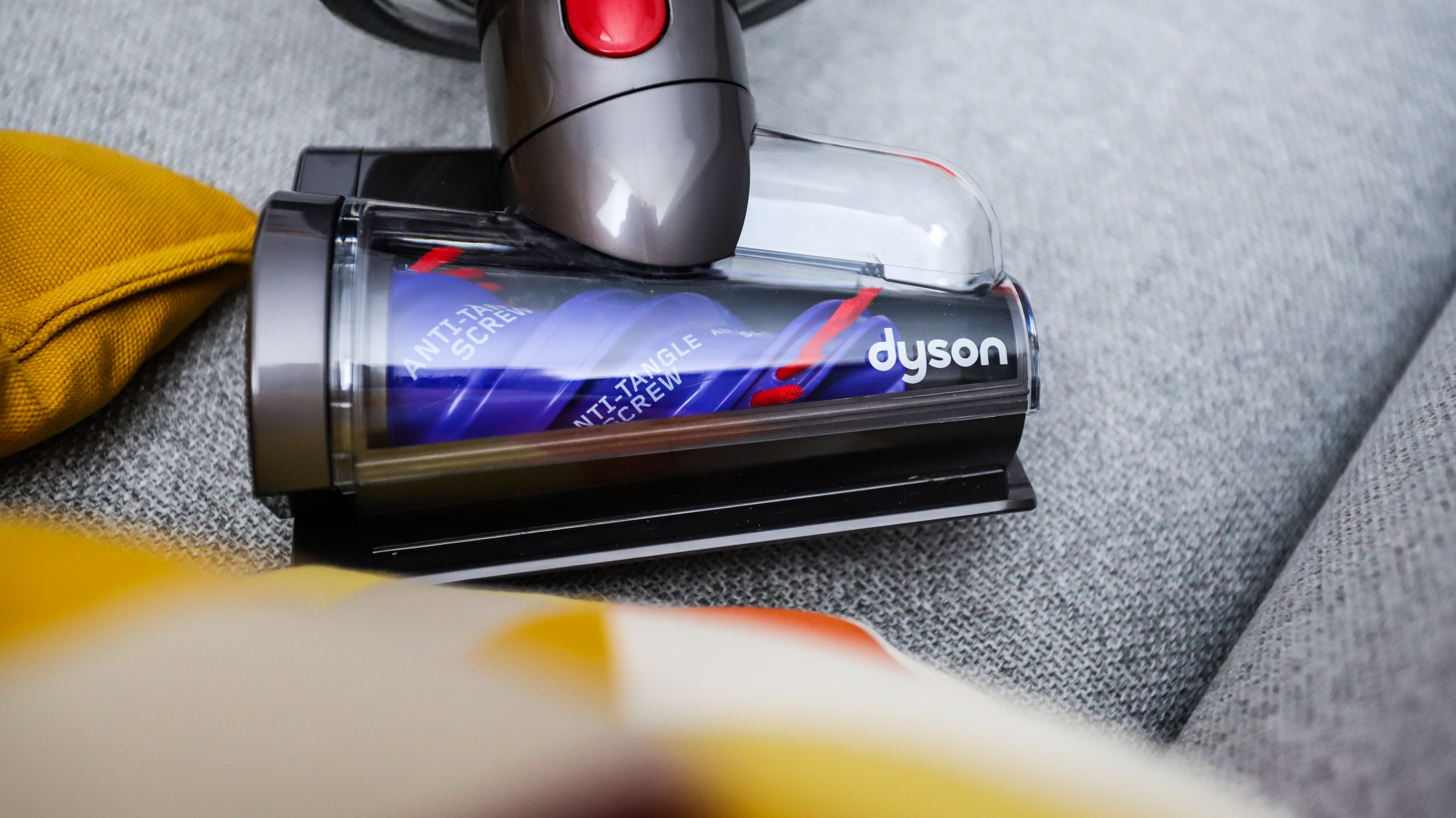
Dyson V15 Detect design
- Sleek in-line design
- Standard 0.76L bin
- Click-in battery
True to Dyson aesthetics, the V15 Detect is a beautiful machine to look at, physically resembling the Dyson V11 models... with just a few small, yet significant, differences.
The main difference is the new Fluffy tool. While its footprint is still the same, it's a lot slimmer than what we've seen in previous models. It also has a small switch on the top to turn on – you probably guessed it – the Class 1 (safe for human and animal eyes) laser diode embedded into one side of the cleaning head.
The diode has been placed at a precise angle and a very specific height. Thanks to a custom-designed lens (which is only marginally bigger than a grain of sugar), the laser emits light at an angle that reflects off solid particles to highlight them green.
The new Fluffy tool – now called Laser Slim Fluffy – has quite a low profile, so it can potentially squeeze into narrow spaces under your furniture. Most importantly, it's washable, so you can keep it at peak performance.
While the Laser Slim Fluffy is meant for hard floors, it’s not easy to swivel around. For that, you’ll need the High Torque head (which debuted with the V11). The upgraded High Torque – meant to be used on rugs and carpets – now features a couple of rows of ‘teeth’ that cut hair and fur into smaller pieces that get sucked up easily and thus prevent tangling around the bristles of the brush.
But because it swivels around a lot more than the Slim Fluffy, we found ourselves using it on hard floors as well – especially since it’s the only cleaning head that allows the V15 Detect to reactively change suction power.
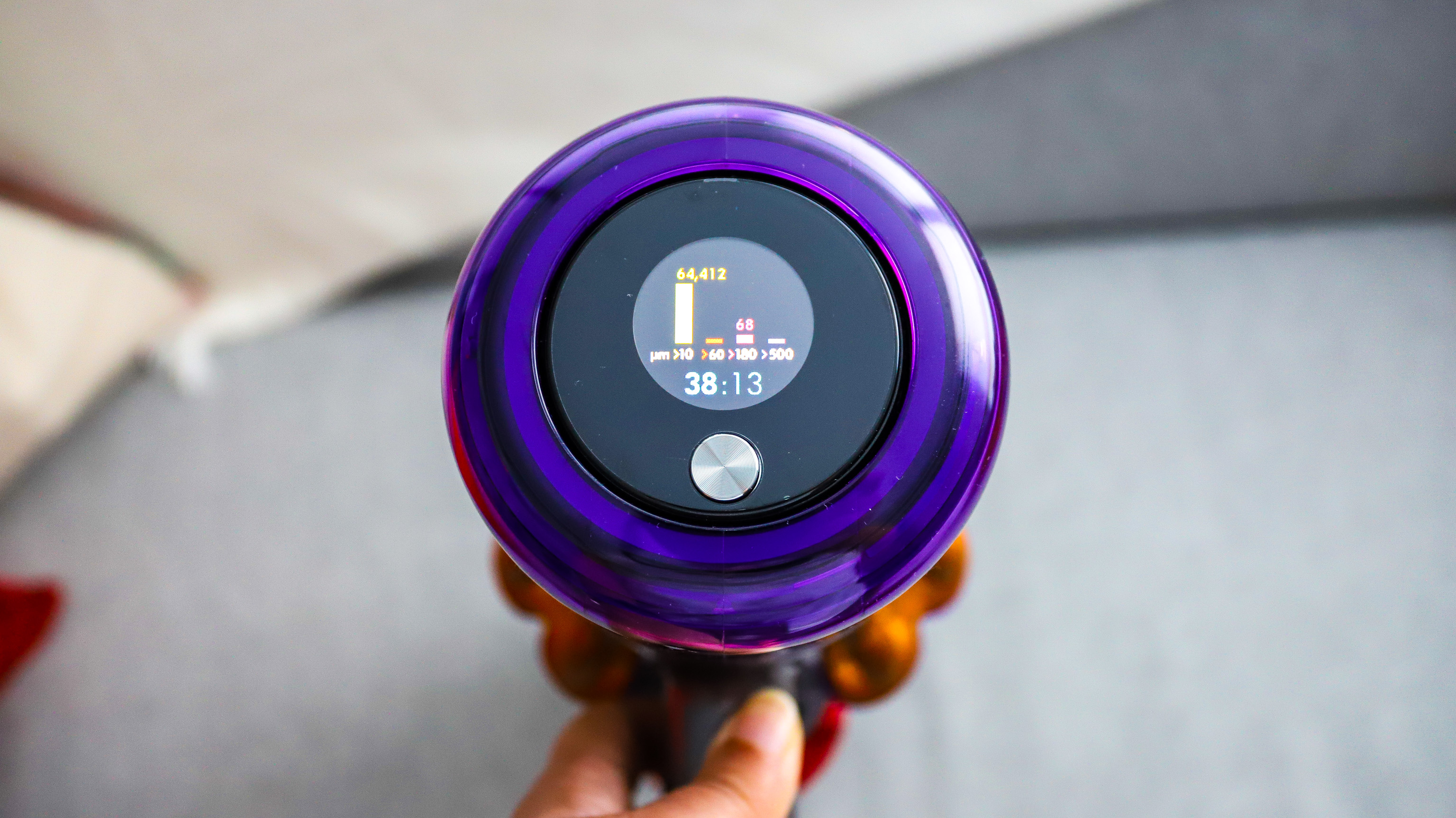
While you can't see the piezo sensor, it's the next headline act of the V15 Detect. This tiny sensor, housed within the vacuum's handheld unit, can measure acoustic vibrations from microscopic particles as small as 10 microns. As dust and debris get sucked in, they reverberate off the sides of the vacuum, and the piezo sensor uses those changes in vibrations to measure not just the size of the particles, but also the number.
These are then graphically displayed on the one-inch circular digital screen inherited from the V11 range. As you clean, you'll see the graphical representation change and, when it finally becomes static, you'll know there's nothing more for the vacuum to suck up.
The display on the rear of the handheld unit isn't only to show a graphical representation of how clean (or dirty) your home is, but it also shows you the power mode you've chosen (along with battery life, which can be changed by pressing the silver button on the circular panel. Displayed below the graph is also a countdown clock representing the remaining runtime.
The innovations don't stop there. A new tool has been specifically designed for human and pet hair. Using the principle of an Archimedes screw, the (perhaps aptly named) Hair Screw Tool has a tapered design that pushes strands of hair or fur (no matter how short or long) towards the narrow end of the cleaning head. Even the bristles have been placed at an angle, all of which ensure there's no tangling at all.
The narrow end is where the suction hole is, allowing whole locks to get sucked up into the bin. The Hair Screw Tool is available to buy separately for use along with the older Dyson handsticks, but comes as a standard part of the V15 package.
While we were hoping that the V15’s bin would be the bigger Outsized version (especially considering the price tag), it comes with the standard 0.76L canister that’s used in the Cyclone V10.
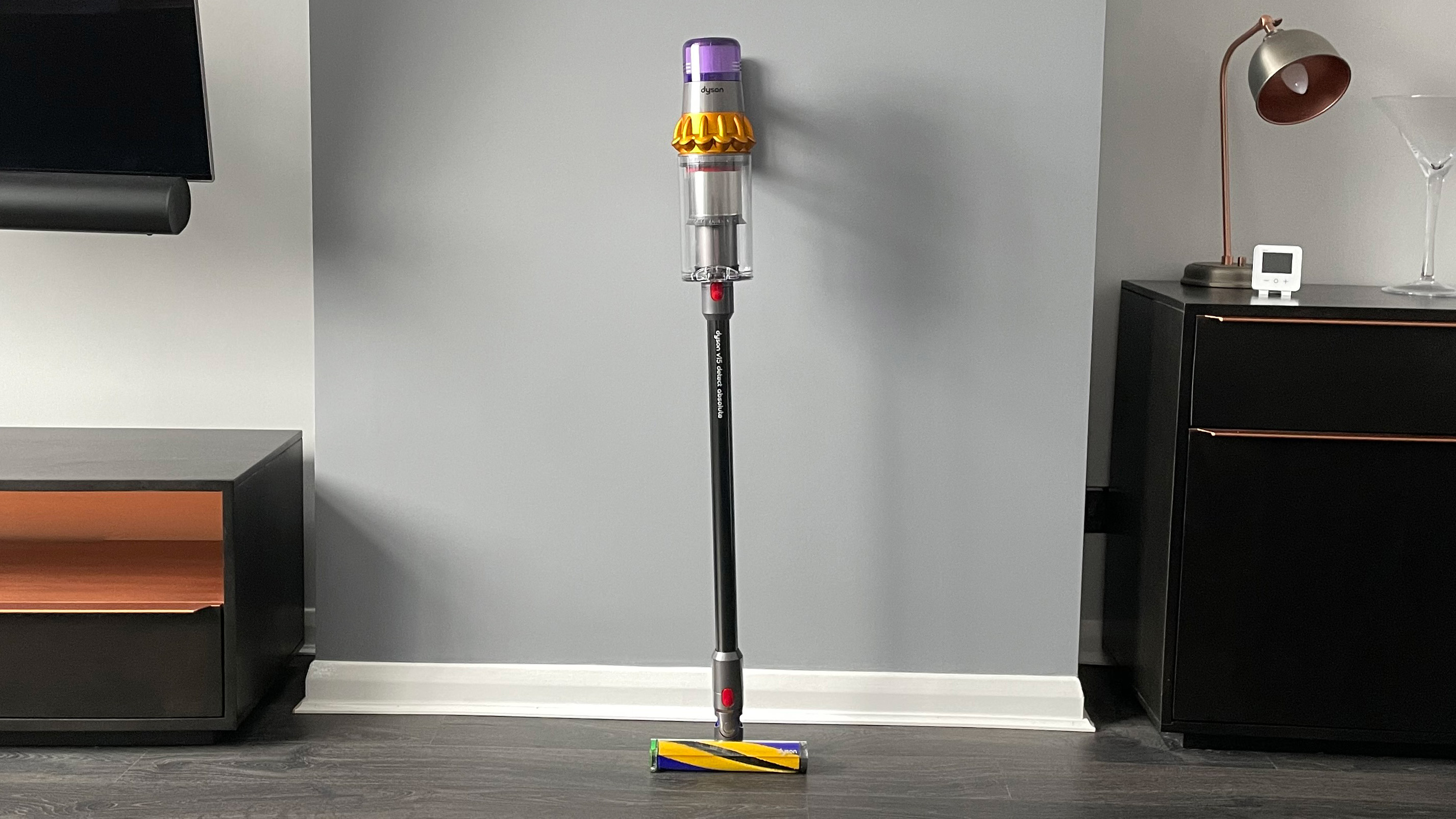
Inherited from the V11 is the swappable battery pack. It’s as yet unclear whether the V11’s click-in replacement battery will work with the V15 (Dyson has not yet listed a specific battery for the new model), but buying an additional battery pack will set you back about AU$199 / NZ$249.
It can come in handy if you’ve got a large home and would prefer to get the vacuuming done in one go instead of recharging at the mains – that can take a few hours (more on that later).
That battery, though, makes the weight distribution of the V15 Detect quite uneven. It weighs in at just 3kg, but feels top-heavy. We found our arms getting tired after using it for about 30 minutes and needed to keep switching hands regularly during a 45-minute cleaning sprint.
If you currently use an older handstick, like the Dyson V7 or a Dyson V8, and plan to upgrade, you’ll also find that the V15 is slightly taller – standing at 126cm as compared to the V8’s 124.4cm.
Despite its weight and height differences, the V15 – like the other Dyson handsticks – quickly converts into a handheld unit that’s perfect for the new Hair Screw Tool on upholstery or pet beds.
That uneven weight distribution, though, doesn’t do your arms any favours when you need to keep the trigger pressed for the entire duration of your vacuuming sprint.
We raised this issue when we tested the V7 and the V8, but those were smaller and lighter models and easy to manoeuvre. Dyson has chosen to remove the trigger from the V12 Detect Slim (which launched alongside the V15) – replacing it with a power button on the barrel instead – and it would have been nice if the heavier flagship also had this feature.
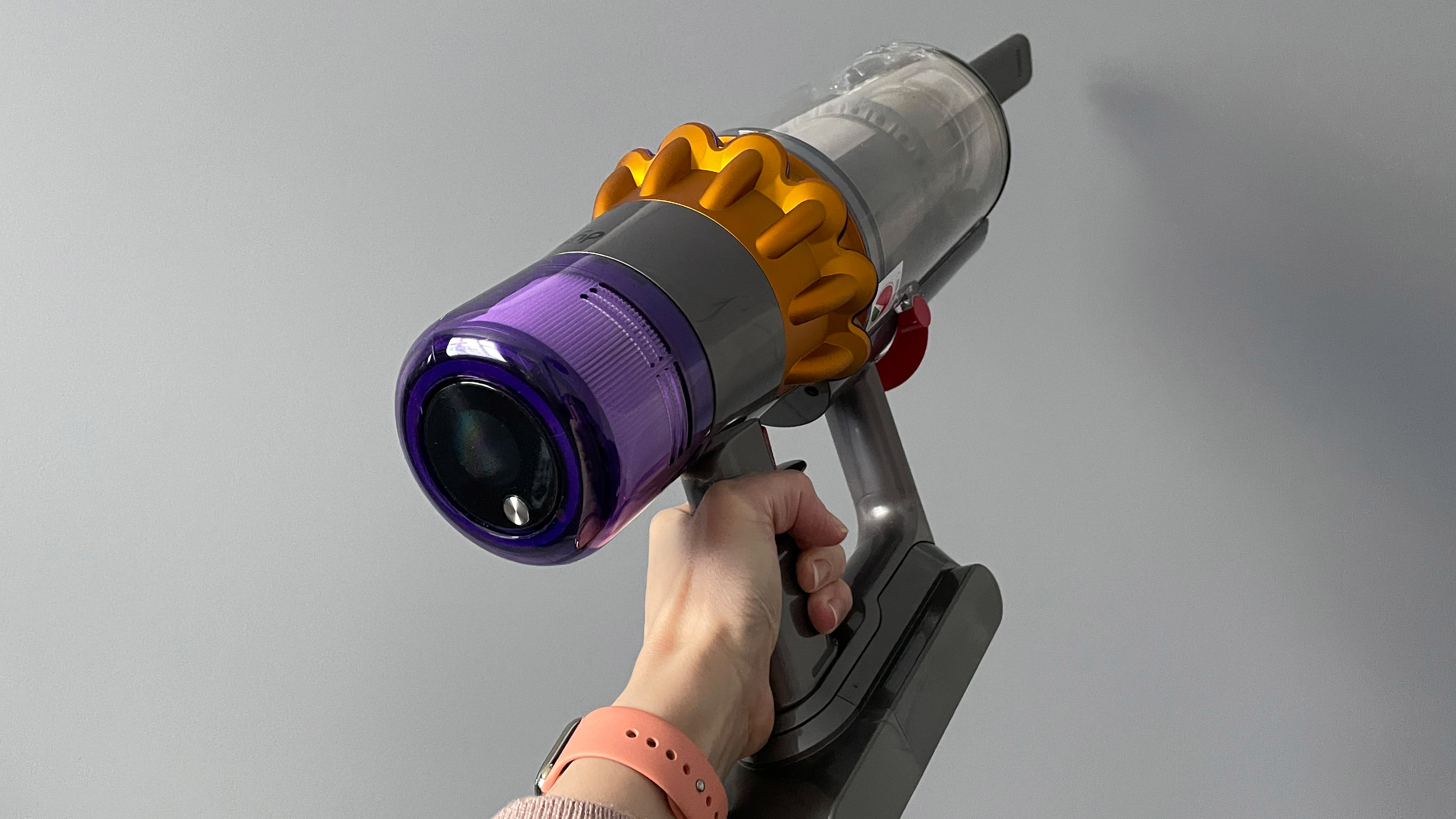
Dyson V15 Detect performance
- Powerful, dynamic suction
- Laser light to illuminate particles
- Three power/suction modes
Even though there are three power modes, the V15 Detect is just fine at its lowest setting. The motor has been improved and now generates 230 air watts, which is 24% more suction than the V11 handsticks. Even in Eco mode, the V15 Detect does a pretty good job on hairy carpets.
During our testing, though, we found the Auto mode the best – it was like a set-and-forget option that handled hard floors and carpets alike. Additionally, when using the redesigned High Torque cleaning head, the suction changes reactively when surfaces change, increasing automatically when the vacuum senses a rug or carpet.
As mentioned earlier, the laser on the Slim Fluffy tool is great – it does exactly what it says on the tin, bringing to light particles you normally wouldn’t see with your naked eye, either highlighted a bright green or as adding shadows and silhouettes you can see.
If you’re really fussy about cleanliness, this is a good thing, but we found that dust tends to settle on the inside plastic of the tool, diminishing its ability to, well, shine a light. This won’t be a huge problem if you vacuum every day or two days, but even a once-weekly vacuum allows enough dust to settle on the floor to coat the diode as the Slim Fluffy runs over the surface.
During our testing, we had to repeatedly wipe down the inside of the Laser Slim Fluffy to get the best results but, after a while, we found it easier to leave it switched off – keeping an eye on the display was more than enough to tell us there was nothing more for the V15 to suck up.
This graphical representation of what you’re cleaning works really well. All particles are divided into four categories, depending on their size, and as you clean a specific surface, you’ll find the bars rising. When they become static, you know that the area has been cleaned to the V15 Detect’s best ability.
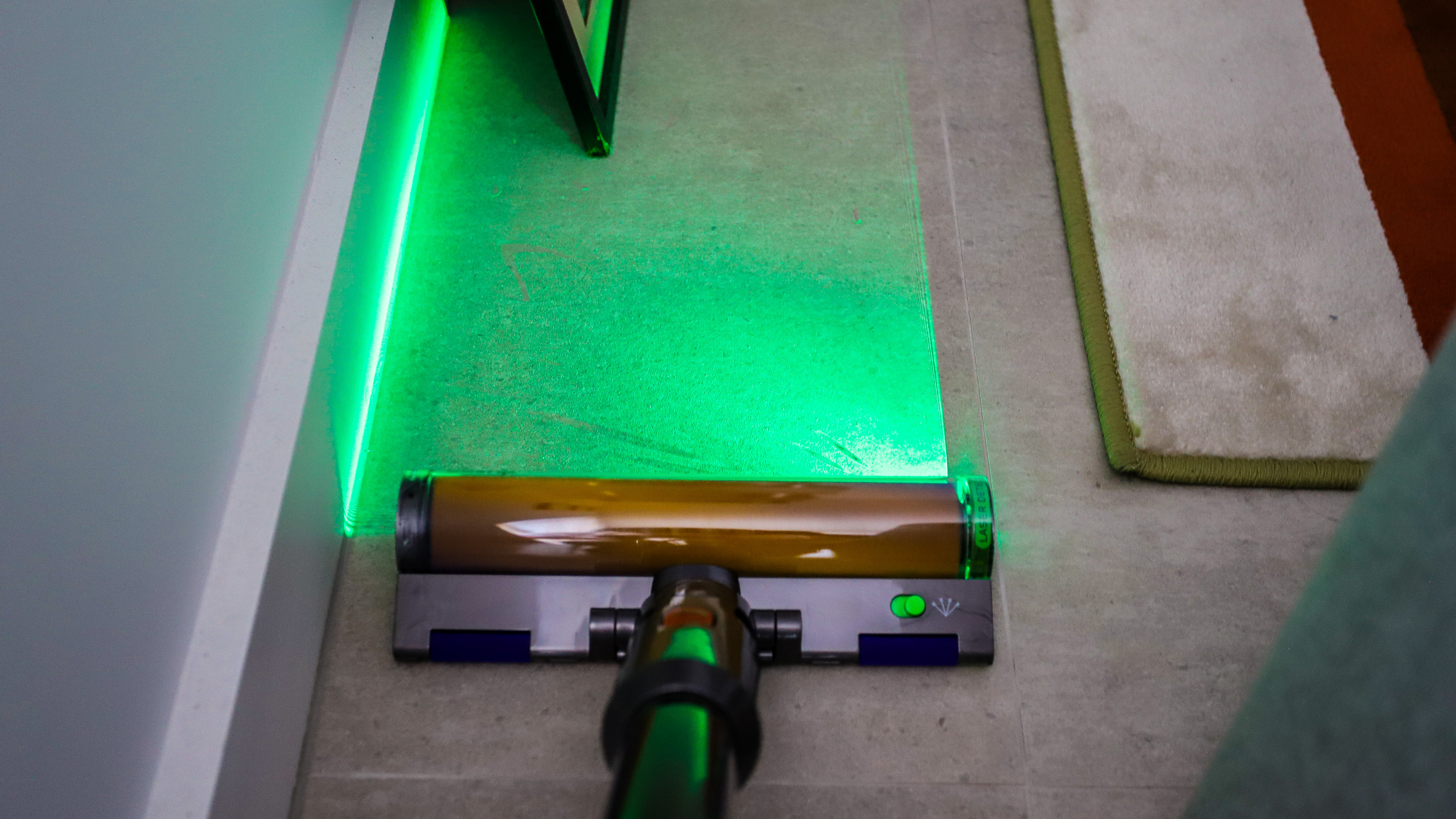
As mentioned, the Dyson V15 Detect also ships with the new anti-tangle Hair Screw Tool. While it’s best suited to be used as part of the handheld unit to remove pet and human hair off smaller surfaces like sofas, car seats or pet beds, you can also use it on carpeted floors.
However, given the small footprint of the Hair Screw Tool, it takes almost double the time to clean a room as compared to using the High Torque attachment. Either way, the Hair Screw Tool is a marvellous piece of engineering. When testing it, we removed a clump of hair from a brush and placed it on a couch – the anti-tangle tool sucked it all up without a single strand getting caught anywhere. It’s all curled up and got sucked right into the canister.
Another impressive engineering feat from Dyson is how much quieter the V15 Detect is in low-power settings as compared to some of the older V-series models. However, bump the suction mode to Boost and it hits 81 decibels – as loud as a truck trundling down a highway at 65kph.
Converting the vacuum to handheld mode and back again is simple – just remove the telescopic tube, clip on your desired attachment and you’re ready to go. However, the click-in battery pack does make the barrel feel heavier than older models like the V7, V8 and V10. In fact, we were comfortable using those older Dysons to clean ceiling corners but holding aloft the V15 for more than a minute or two is quite difficult.
Emptying the V15 Detect’s bin, like before, is easy though. Once the wand and any cleaning attachments are removed, the red lever on the canister pushes open the lid and all that dirt comes right out in a single move.
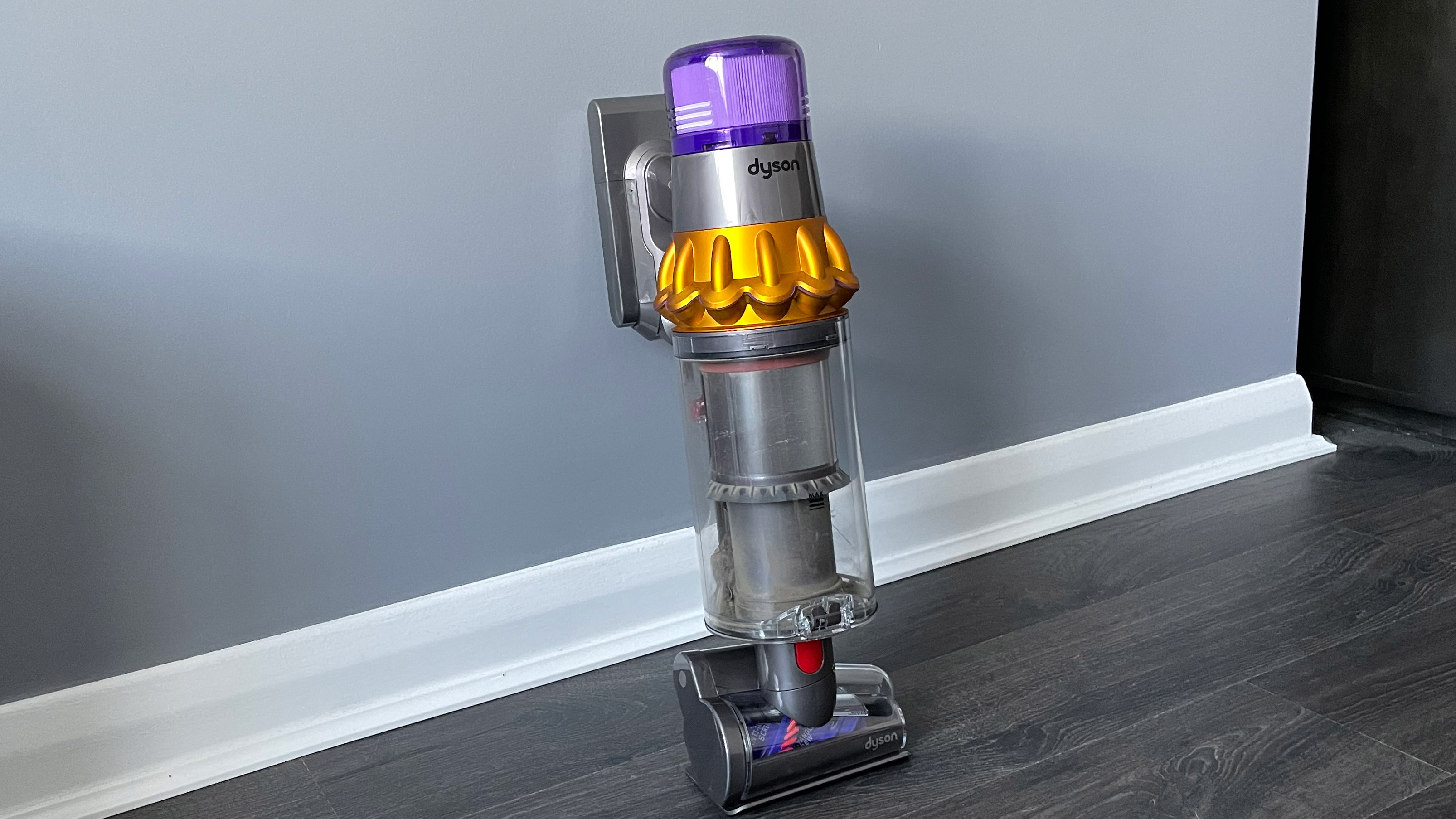
Dyson V15 Detect battery life
- Up to 60 minutes of fade-free power
- Recharges in about 5 hours
- Swappable battery packs
Dyson hasn’t done much to improve the battery life of its new handstick over the V11 range. It’s still a top of 60 minutes. However, there's more suction power, so chances are high you'll finish cleaning quicker.
That full 60-minute runtime is what you’ll get at the lowest (Eco) suction mode. Our stopwatch clocked up a full 60:54 minutes in this mode, then took a little over 4 hours to fully recharge.
Like us, if you prefer the Auto mode, you’ll get about 40 minutes of runtime per charge, which is enough for the general upkeep of a small two-bedder. Bump that up to Boost and you’ll only get about 18 minutes of power.
As mentioned before, we found the Auto mode suited us best, but even the Eco setting has plenty of suction power to clean up a small mess. So the latter is your best bet to maximise on battery life. A countdown of how long you have left is handily available on the digital display.
If you’d like to improve on the 60-minute runtime, then you’re going to need an additional battery pack. This would be handy in large family homes, where you won’t get a four-hour interruption to finish vacuuming.
Should I buy the Dyson V15 Detect?
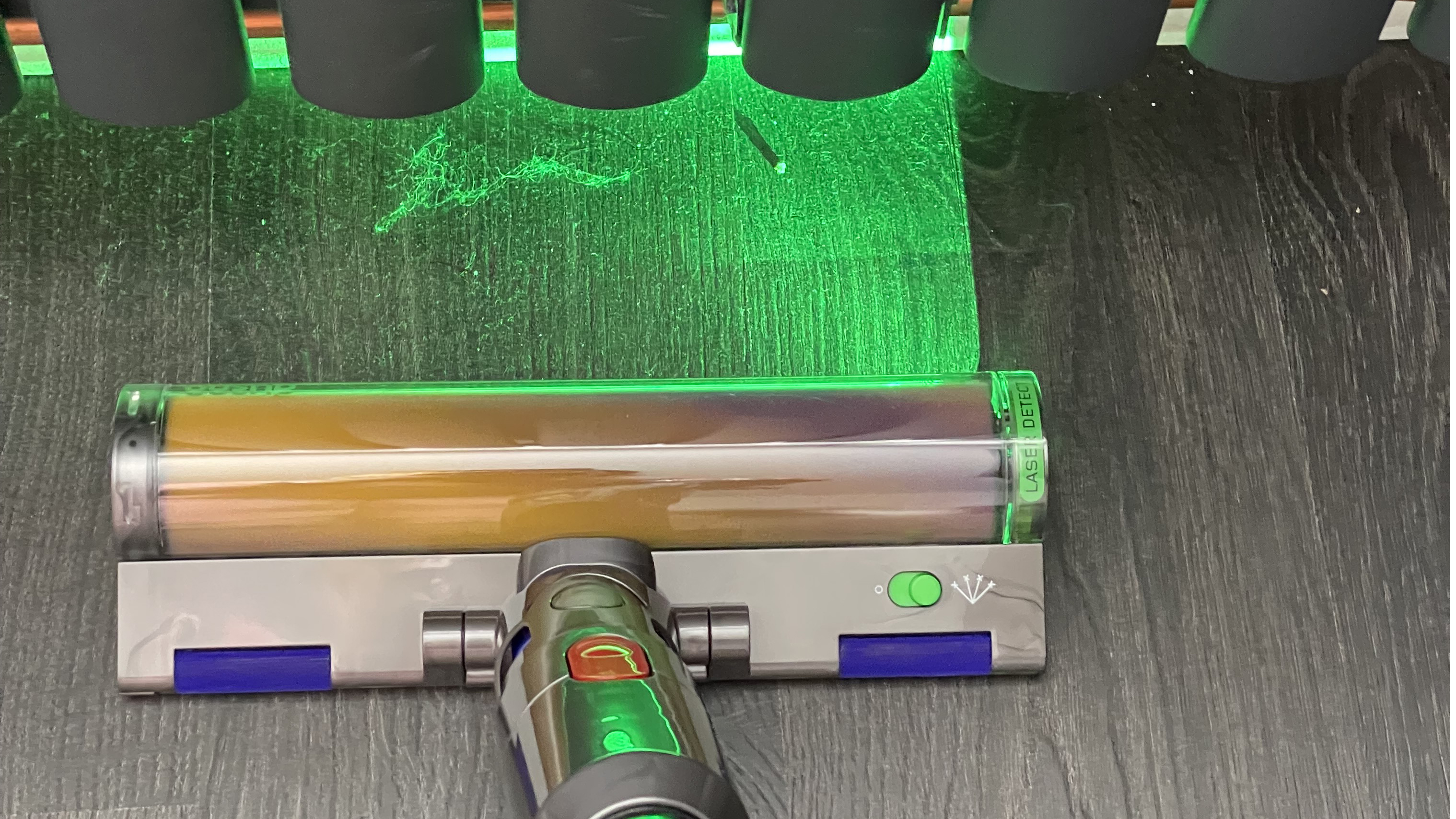
Buy it if...
Your home mostly has hard floors and houses a pet too
The V15 Detect comes with the Laser Slim Fluffy cleaning head by default and that’s best used on hard floors. Sure, it will suck up dust from carpets, but it’s not going to shred up human or pet hair. Plus it comes with tools that treat hair and fur exactly how they ought to be – shredded or sucked up into a bin. So if you can pay the hefty price of the V15, then we’d recommend it’s best for homes that mostly have hard floors – tile or wood – and for households with pets.
You want "scientific proof" that your home is clean
Between the piezo sensor and laser beam, there’s no doubt that the Dyson has pulled off another engineering masterpiece. You can now see what you need to clean up (even if it’s invisible to the naked eye) and see how much of it you’ve captured. It’s great to have that reassurance, especially during these pandemic times.
You want the most powerful Dyson handstick yet
If money is no object, then the V15 Detect is, hands-down, the most powerful Dyson cordless vacuum cleaner we’ve tested. Even on Eco mode, it’s a great sucker, and leaving it on Auto mode is even better. It can match any corded option, even one of our favourite vacuum cleaners, the Miele Blizzard CX1 Excellence.
Don't buy it if...
You’re on a budget
How much you’re willing to spend on something is always an important consideration, and the V15 Detect is Dyson’s most expensive product to date. If you don’t have pets at home, you could consider buying an older Dyson model – the Cyclone V10 is pretty powerful, as is the much older V8. And they’re also a lot more affordable than the V15 or even the V11 Outsize.
You live in a large home
The 0.76L bin, while fine for the average two- or three-bedroom home, might be too small for a larger family home. If you live in a large space, you’ll find your cleaning run being interrupted by trips to the dustbin to empty the canister. And you may find the V15 Detect running out of battery before you finish your clean. Buying an extra battery is advisable, but that’s an additional cost that you may not wish to tack on.
0 comments:
Post a Comment